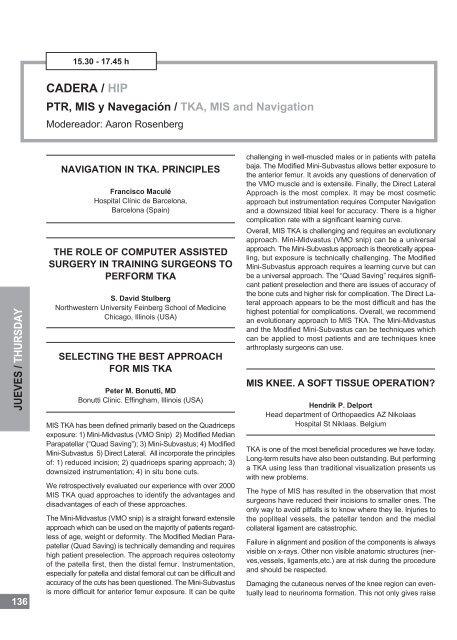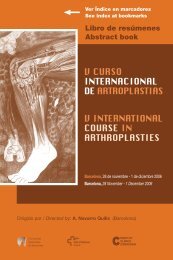Notas / Notes - Active Congress.......
Notas / Notes - Active Congress.......
Notas / Notes - Active Congress.......
Create successful ePaper yourself
Turn your PDF publications into a flip-book with our unique Google optimized e-Paper software.
JUEVES / THURSDAY<br />
136<br />
15.30 - 17.45 h<br />
CADERA / HIP<br />
PTR, MIS y Navegación / TKA, MIS and Navigation<br />
Modereador: Aaron Rosenberg<br />
NAVIGATION IN TKA. PRINCIPLES<br />
Francisco Maculé<br />
Hospital Clínic de Barcelona,<br />
Barcelona (Spain)<br />
THE ROLE OF COMPUTER ASSISTED<br />
SURGERY IN TRAINING SURGEONS TO<br />
PERFORM TKA<br />
S. David Stulberg<br />
Northwestern University Feinberg School of Medicine<br />
Chicago, Illinois (USA)<br />
SELECTING THE BEST APPROACH<br />
FOR MIS TKA<br />
Peter M. Bonutti, MD<br />
Bonutti Clinic. Effingham, Illinois (USA)<br />
MIS TKA has been defined primarily based on the Quadriceps<br />
exposure: 1) Mini-Midvastus (VMO Snip) 2) Modified Median<br />
Parapatellar (“Quad Saving”); 3) Mini-Subvastus; 4) Modified<br />
Mini-Subvastus 5) Direct Lateral. All incorporate the principles<br />
of: 1) reduced incision; 2) quadriceps sparing approach; 3)<br />
downsized instrumentation; 4) in situ bone cuts.<br />
We retrospectively evaluated our experience with over 2000<br />
MIS TKA quad approaches to identify the advantages and<br />
disadvantages of each of these approaches.<br />
The Mini-Midvastus (VMO snip) is a straight forward extensile<br />
approach which can be used on the majority of patients regardless<br />
of age, weight or deformity. The Modified Median Parapatellar<br />
(Quad Saving) is technically demanding and requires<br />
high patient preselection. The approach requires osteotomy<br />
of the patella first, then the distal femur. Instrumentation,<br />
especially for patella and distal femoral cut can be difficult and<br />
accuracy of the cuts has been questioned. The Mini-Subvastus<br />
is more difficult for anterior femur exposure. It can be quite<br />
challenging in well-muscled males or in patients with patella<br />
baja. The Modified Mini-Subvastus allows better exposure to<br />
the anterior femur. It avoids any questions of denervation of<br />
the VMO muscle and is extensile. Finally, the Direct Lateral<br />
Approach is the most complex. It may be most cosmetic<br />
approach but instrumentation requires Computer Navigation<br />
and a downsized tibial keel for accuracy. There is a higher<br />
complication rate with a significant learning curve.<br />
Overall, MIS TKA is challenging and requires an evolutionary<br />
approach. Mini-Midvastus (VMO snip) can be a universal<br />
approach. The Mini-Subvastus approach is theoretically appealing,<br />
but exposure is technically challenging. The Modified<br />
Mini-Subvastus approach requires a learning curve but can<br />
be a universal approach. The “Quad Saving” requires significant<br />
patient preselection and there are issues of accuracy of<br />
the bone cuts and higher risk for complication. The Direct Lateral<br />
approach appears to be the most difficult and has the<br />
highest potential for complications. Overall, we recommend<br />
an evolutionary approach to MIS TKA. The Mini-Midvastus<br />
and the Modified Mini-Subvastus can be techniques which<br />
can be applied to most patients and are techniques knee<br />
arthroplasty surgeons can use.<br />
MIS KNEE. A SOFT TISSUE OPERATION?<br />
Hendrik P. Delport<br />
Head department of Orthopaedics AZ Nikolaas<br />
Hospital St Niklaas. Belgium<br />
TKA is one of the most beneficial procedures we have today.<br />
Long-term results have also been outstanding. But performing<br />
a TKA using less than traditional visualization presents us<br />
with new problems.<br />
The hype of MIS has resulted in the observation that most<br />
surgeons have reduced their incisions to smaller ones. The<br />
only way to avoid pitfalls is to know where they lie. Injuries to<br />
the popliteal vessels, the patellar tendon and the medial<br />
collateral ligament are catastrophic.<br />
Failure in alignment and position of the components is always<br />
visible on x-rays. Other non visible anatomic structures (nerves,vessels,<br />
ligaments,etc.) are at risk during the procedure<br />
and should be respected.<br />
Damaging the cutaneous nerves of the knee region can eventually<br />
lead to neurinoma formation. This not only gives raise





